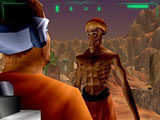 When
I first heard about Outcast some time ago, I was initially excited about the scope of the
project. From all descriptions, it was to have hundreds of developed characters, multiple
massive continents to explore, 50+ hours of gameplay, action and adventure all in one.
Everything pointed to an instant classic. I was just hoping that I’d get
the chance to play the game. And now that I have, I’m not entirely sure how I feel
about it. As far as adventure gaming goes, first-time developer Appeal has set a new
high-bar for complex, well-written game storylines, though as far as action, this game has
taken a couple steps backward. It’s not horrible, it’s just kind of
disappointing.
When
I first heard about Outcast some time ago, I was initially excited about the scope of the
project. From all descriptions, it was to have hundreds of developed characters, multiple
massive continents to explore, 50+ hours of gameplay, action and adventure all in one.
Everything pointed to an instant classic. I was just hoping that I’d get
the chance to play the game. And now that I have, I’m not entirely sure how I feel
about it. As far as adventure gaming goes, first-time developer Appeal has set a new
high-bar for complex, well-written game storylines, though as far as action, this game has
taken a couple steps backward. It’s not horrible, it’s just kind of
disappointing. 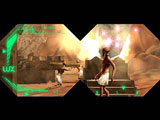 As the story of
Outcast begins, the US military has sent a probe into an alternate parallel universe.
Upon landing on the beautifully voxel-rendered planet of Adelpha, it somehow
triggers a black hole that now imperils our own world. "You are Cutter Slade,
Commander of an elite team of scientists chosen to embark on a high stakes mission that
will determine the fate of the earth." Hilarious names aside, as well as the obvious
influences of Stargate, the plot centers around your character awaking and being perceived
as a messiah, and French fashion victim, come to end all of the peaceful inhabitants of
Adelpha’s problems. You must now wander the planet and find a way to bring about
peace–through sneaking, shooting, and sidequests.
As the story of
Outcast begins, the US military has sent a probe into an alternate parallel universe.
Upon landing on the beautifully voxel-rendered planet of Adelpha, it somehow
triggers a black hole that now imperils our own world. "You are Cutter Slade,
Commander of an elite team of scientists chosen to embark on a high stakes mission that
will determine the fate of the earth." Hilarious names aside, as well as the obvious
influences of Stargate, the plot centers around your character awaking and being perceived
as a messiah, and French fashion victim, come to end all of the peaceful inhabitants of
Adelpha’s problems. You must now wander the planet and find a way to bring about
peace–through sneaking, shooting, and sidequests.
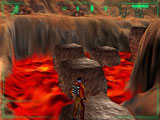 Outcast does, in fact, boast
six genuinely large continents. The first and smallest, Ranzarr, is a snow world set up
primarily to introduce you to the game and provide you with a little training and
background. Then you are on to Shamazaar, the temple world that really starts the game.
You progress through Okasankaar, the marsh world, Talanzaar, the city world, Motazaar, the
mountain world, and Okaar the forest world, with its carnivorous plantlife. Each of
the continents have their own particular flavor, and each presents new challenges and more
folks to talk to, as well as new heights in visual splendor. These environments, if you
tweak your graphics, are really rich and incredible.
Outcast does, in fact, boast
six genuinely large continents. The first and smallest, Ranzarr, is a snow world set up
primarily to introduce you to the game and provide you with a little training and
background. Then you are on to Shamazaar, the temple world that really starts the game.
You progress through Okasankaar, the marsh world, Talanzaar, the city world, Motazaar, the
mountain world, and Okaar the forest world, with its carnivorous plantlife. Each of
the continents have their own particular flavor, and each presents new challenges and more
folks to talk to, as well as new heights in visual splendor. These environments, if you
tweak your graphics, are really rich and incredible.
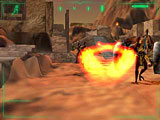 If your PC is like mine--in that
limbo between required and recommended requirements, out of the box the game doesn’t
look all that impressive, in fact, I initially felt a little discouraged. With the factory
defaults on it looks no better than something on the PlayStation. Fortunately there’s
an excellent array of performance options to optimize graphics and sound. First of all,
you’re going to want to crank up the bump mapping and character detail, unless you
feel that you can be fooled into believing that those big black rectangles are in fact
your character’s feet. The cinemascope option renders the game in a 16/9 aspect ratio
window, kind of like a letterboxed version of the game, and I’m still not sure how I
feel about this one. It does noticeably improve the performance of the game, but all that
blank space on my screen seems sort of wasted. More than anything, you're going to want
set the antialiasing to high. Post rendering enables those cool water and fog effects
I’m sure you’ve marveled at in the screen shots. You can also use the large
crowd setting to increase the citizenry of the towns in the game. While you're there,
enable the 3D sound and ambient sounds--they make a big difference in the feel of the
game. Now that you’ve got the game looking and sounding like it should you can get on
with the play. Oh, and force feedback is supported though I really have no idea why.
If your PC is like mine--in that
limbo between required and recommended requirements, out of the box the game doesn’t
look all that impressive, in fact, I initially felt a little discouraged. With the factory
defaults on it looks no better than something on the PlayStation. Fortunately there’s
an excellent array of performance options to optimize graphics and sound. First of all,
you’re going to want to crank up the bump mapping and character detail, unless you
feel that you can be fooled into believing that those big black rectangles are in fact
your character’s feet. The cinemascope option renders the game in a 16/9 aspect ratio
window, kind of like a letterboxed version of the game, and I’m still not sure how I
feel about this one. It does noticeably improve the performance of the game, but all that
blank space on my screen seems sort of wasted. More than anything, you're going to want
set the antialiasing to high. Post rendering enables those cool water and fog effects
I’m sure you’ve marveled at in the screen shots. You can also use the large
crowd setting to increase the citizenry of the towns in the game. While you're there,
enable the 3D sound and ambient sounds--they make a big difference in the feel of the
game. Now that you’ve got the game looking and sounding like it should you can get on
with the play. Oh, and force feedback is supported though I really have no idea why.
There is an incredible amount of dialogue in Outcast, and it's also incredible that the
greater part of it is useful. The problem here is that the inhabitants of Adelpha sprinkle
their language–i.e. what you hear–with a respectable amount local vernacular.
From the standpoint of providing an engaging way for the player to enter the world of the
game, the vocabulary is effective, although I worry that this may turn off some gamers
uninterested in the anthropology of Adelpha. The lexicon may then just seem superfluous to
gameplay.
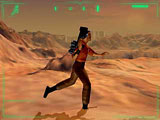 Most of the game is best spent
in third-person view, except when you're using a weapon, where first-person is ideal.
There are also some views that are in-between third and first that may come in handy now
and then. Instead of walking or running, riding the two-legged Twon-ha expedites travel
exponentially. You can even fight on it, and I wonder if this animal is related to
ESB’s Taun-Taun. You also have a small inventory to keep in your backpack as well as
a notepad to keep track of your quests and a lexicon display to figure out what everyone
is saying.
Most of the game is best spent
in third-person view, except when you're using a weapon, where first-person is ideal.
There are also some views that are in-between third and first that may come in handy now
and then. Instead of walking or running, riding the two-legged Twon-ha expedites travel
exponentially. You can even fight on it, and I wonder if this animal is related to
ESB’s Taun-Taun. You also have a small inventory to keep in your backpack as well as
a notepad to keep track of your quests and a lexicon display to figure out what everyone
is saying.
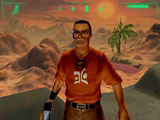 The weapons of Outcast come in
the form of six fairly typical gaming types: basic pistol, dart gun, mortar-style gun,
flame thrower-thingy and the very cooly named Perforator gun, and each can be upgraded.
While playing you need to remember that using your weapons on the good guys will kill you,
so be careful. The review guide that I received with the game states that the best way to
"beat the enemies . . . is to run towards them, strafing left and right and firing
constantly." This appears to be true. Remember to strafe widely left and right, as
there is little precision with any of the weapons, but also remember to be careful. Most
"combat" is done by sneaking around since taking on enemies from the front will
invariably lead to your death. Unfortunately, sneaking around in this game is not nearly
as fun as in Thief: the Dark Project. You can achieve invisibility for short periods
using the Proton Phase Shifter, which alleviates some of the frustration. And, your
binoculars also have an X-ray mode to look inside buildings. The coolest, however, is the
use of a hologram of yourself to draw away enemies. But all of these nifty gadgets
don’t make up for the inherent problems with the action of shooting things, which I
think most all gamers expect.
The weapons of Outcast come in
the form of six fairly typical gaming types: basic pistol, dart gun, mortar-style gun,
flame thrower-thingy and the very cooly named Perforator gun, and each can be upgraded.
While playing you need to remember that using your weapons on the good guys will kill you,
so be careful. The review guide that I received with the game states that the best way to
"beat the enemies . . . is to run towards them, strafing left and right and firing
constantly." This appears to be true. Remember to strafe widely left and right, as
there is little precision with any of the weapons, but also remember to be careful. Most
"combat" is done by sneaking around since taking on enemies from the front will
invariably lead to your death. Unfortunately, sneaking around in this game is not nearly
as fun as in Thief: the Dark Project. You can achieve invisibility for short periods
using the Proton Phase Shifter, which alleviates some of the frustration. And, your
binoculars also have an X-ray mode to look inside buildings. The coolest, however, is the
use of a hologram of yourself to draw away enemies. But all of these nifty gadgets
don’t make up for the inherent problems with the action of shooting things, which I
think most all gamers expect.
Coming on the heels of reviewing System Shock 2, a game that I feel all gamers should
at least take a crack at, Outcast presented me with the challenge of playing a game that
could be shoehorned into the same genre of SS2 but consisted of an entirely different
style of gameplay. I’m not referring to the fact that Outcast is best played in
third-person, but that it feels . . . well, for lack of better terms, foreign. Not that I
think that is necessarily bad or anything, it just took me quite awhile to get into the
game, what with the thick spread of local lingo and all of the chatting. The action also
seemed to lack a little. Nonetheless, Outcast is a good game, and this kind of immersive
gaming is just starting to build an audience. Give Outcast a try, it may be right up your
alley, and then again, it may not.
--Thomas Hoff

 When
I first heard about Outcast some time ago, I was initially excited about the scope of the
project. From all descriptions, it was to have hundreds of developed characters, multiple
massive continents to explore, 50+ hours of gameplay, action and adventure all in one.
Everything pointed to an instant classic. I was just hoping that I’d get
the chance to play the game. And now that I have, I’m not entirely sure how I feel
about it. As far as adventure gaming goes, first-time developer Appeal has set a new
high-bar for complex, well-written game storylines, though as far as action, this game has
taken a couple steps backward. It’s not horrible, it’s just kind of
disappointing.
When
I first heard about Outcast some time ago, I was initially excited about the scope of the
project. From all descriptions, it was to have hundreds of developed characters, multiple
massive continents to explore, 50+ hours of gameplay, action and adventure all in one.
Everything pointed to an instant classic. I was just hoping that I’d get
the chance to play the game. And now that I have, I’m not entirely sure how I feel
about it. As far as adventure gaming goes, first-time developer Appeal has set a new
high-bar for complex, well-written game storylines, though as far as action, this game has
taken a couple steps backward. It’s not horrible, it’s just kind of
disappointing.